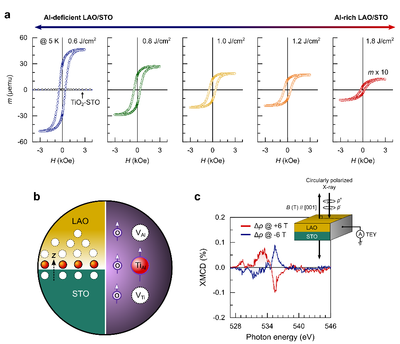
Figure: a. 5 K magnetic hysteresis loops of the 9-unit cell LaAlO3(001)/TiO2-terminated SrTiO3(001) samples as a function of PLD laser fluence. b. A Schematic showing the consecutive atomic charge compensation via Ti out-diffusion, the resulting B-site cation defect ordering, and the formation of magnetic moments across the interface. c. O K-edge XMCD spectra, measured by swapping the applied magnetic field, B = +6 and -6 T. The inset shows a schematic of the XMCD measurement setup. The total electron yield (TEY) detection is obtained through excitation by using circularly polarized light (ρ+/ρ−) in normal incidence while applying an external magnetic field along the out-of-plane directions.
Cerdanyola del Vallès, August 20th, 2020. Complex oxides show extreme sensitivity to structural distortions and defects, and the intricate balance of competing interactions, which emerge at atomically defined interfaces, may give rise to unexpected physics.
In the non-magnetic complex oxide interfaces, it is unclear which defects are responsible for the emergent magnetic interfaces. In this work, authors from the Swiss Federal Institute of Technology—EPFL , the ALBA Synchrotron, the Chalmers University of Technology (Sweden), the Institut für Physik - Martin-Luther-Universität, the Max Planck Institute of Microstructure Physics (Germany), Institute of Theoretical Physics, Johannes Kepler University (Austria) ant the Technical University of Denmark; have discovered that the B-site cation stoichiometry is crucial for the creation and control of the magnetism at the interface between the ABO3-perovskite oxides, lanthanum aluminate (LaAlO3) and strontium titanate (SrTiO3).
The discovery in 2004 that a conducting quasi-two dimensional electron system is formed at the interface between two band insulating oxides set off a rapidly growing research field on complex oxide heterostructures. Here, the authors resolved a long-standing puzzle for the interface magnetism in the ABO3-perovskite band insulators, LaAlO3 (LAO) and SrTiO3 (STO). The authors’ findings present a new perspective for the understanding of interfacial magnetism by the research community.
The researchers highlight that the tunability of interface magnetism offers a significant advancement and the ability to engineer rich oxide-interface materials for spin-based energy applications such as low-energy consumption electronics.
The work shows the design and fabrication of atomically defined LAO/STO interfaces via controlling the cation stoichiometry of an epitaxial LAO ultrathin layer by pulsed laser deposition (PLD). The results clarify the Al deficiency of LAO upper layer in the LAO/STO heterostructures plays a crucial role in creating and tuning the interfacial magnetism. The Al deficiency initiates a consecutive B-site cation defect formation through atomic charge compensation, which establishes the formation of preferential perpendicular magnetic moments at the interface. Moreover, the authors determined that the B-site cation defects significantly leads to spin polarization of the neighboring ions, especially the neighboring oxygen ions.
Such a unique magnetic nature was proved experimentally by conducting a magnetic field swap of O K-edge X-ray magnetic circular dichroism (XMCD) at the BOREAS beamline in ALBA in combination with magnetotransport measurements, and theoretically supported by first-principles density functional theory calculations.
Reference: D.-S. Park, A. D. Rata, I. V. Maznichenko, S. Ostanin, Y. L. Gan, S. Agrestini, G. J. Rees, M. Walker, J. Li, J. Herrero-Martin, G. Singh, Z. Luo, A. Bhatnagar, Y. Z. Chen, V. Tileli, P. Muralt, A. Kalaboukhov, I. Mertig, K. Dörr, A. Ernst & N. Pryds. The emergence of magnetic ordering at complex oxide interfaces tuned by defects. Nat. Commun. 11, 3650 (2020), https://doi.org/10.1038/s41467-020-17377-0




